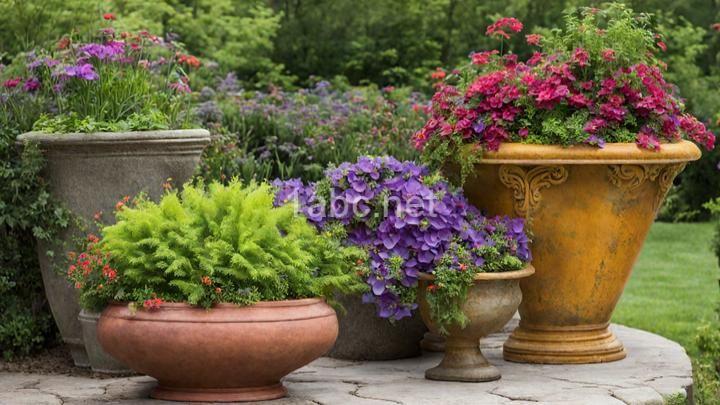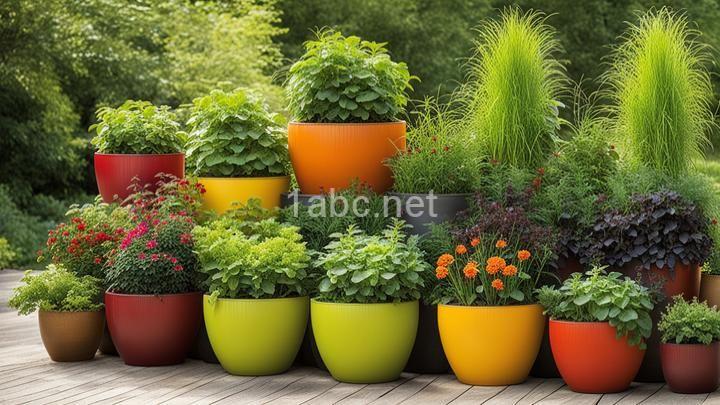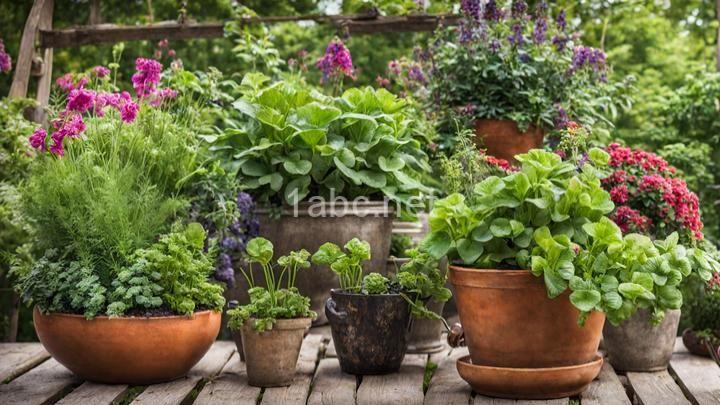Creating a Colorful Container Garden: Plant Compatibility for Stunning Visual Impact

Introduction:
Hello and welcome to our blog! Today, we are going to embark on an exciting journey of creating a vibrant and colorful container garden. There's something magical about bringing together various plants in a confined space and watching them flourish with stunning visual impact. But before we dive into the world of plant combinations, let's take a moment to understand the importance of plant compatibility in achieving our desired outcome.
Section 1: Choosing Containers
When it comes to container gardening, the first step is to carefully select the containers that will house our plants. There are various options available, including pots, hanging baskets, and window boxes. Each container type has its own unique charm and practicality, so choose the ones that complement the overall design and style of your garden.
For smaller plants, opt for smaller containers to avoid overwhelming their growth. On the other hand, larger plants need more space to spread their roots and grow, so choose bigger containers accordingly. Remember, the container size should be proportionate to the size of the plants you are planning to grow.
Section 2: Selecting Plants for Color
Now that we have our containers, it's time to choose the stars of our container garden – the plants! Color is the key to creating an eye-catching display, so let's focus on selecting plants that bring a burst of hues to our garden.
When it comes to flowers, there are endless possibilities. Consider vibrant annuals such as petunias, marigolds, and zinnias for a riot of color. Mix and match different flower colors to create a harmonious blend or opt for contrasting colors for a bold statement. Don't forget to include foliage plants like coleus or caladiums, which provide stunning colors even without flowers.
If you enjoy fresh produce, why not incorporate edible plants into your container garden? Some vegetables and herbs, like rainbow chard, Swiss chard, and purple basil, not only add an array of colors but also bring delicious flavors to your plate.
As you select plants, keep in mind their height, growth habits, and bloom times. Aim for a well-balanced composition by combining plants that vary in height, ensuring that taller plants provide a backdrop for the shorter ones. Consider the plants' growth habits – some plants may spread and fill out the container, while others may grow more upright. Additionally, choose plants with different bloom times to ensure a continuous display of color throughout the growing season.
Section 3: Considering Light Requirements
Understanding the light requirements of each plant is crucial for their overall health and success. Some plants thrive in shade, others prefer partial sun or partial shade, while some bask in full sun. Categorizing plants based on their light needs will help us create harmonious combinations that thrive together.
For shady spots, consider plants like impatiens, begonias, and ferns that flourish in low light conditions. If your garden receives partial sun or shade, opt for plants like geraniums, salvia, or coleus. And if you have a sunny spot, the options are endless – dahlias, marigolds, and sunflowers will thrive in full sun.
When pairing plants for their light requirements, ensure that the taller plants do not cast shade on their shorter companions, as this can hinder their growth and overall appearance.
Section 4: Understanding Watering Needs
Matching plants with similar watering needs is essential to avoid under or overwatering issues. Different plants have different moisture requirements, so it's crucial to assess soil moisture levels and water frequency accordingly.
Before watering, check the moisture level of the soil by sticking your finger about an inch deep into the soil. If it feels dry, it's time to water. If it's still moist, hold off for a little longer. Overwatering can lead to root rot, while underwatering can cause plants to wilt and potentially die.
To simplify maintenance, group plants with similar water requirements together. This way, you can water them as a cohesive unit and ensure that each plant receives the appropriate amount of water.
Section 5: Complementing Textures and Forms
To take our container garden to the next level, let's explore the world of textures and forms. Incorporating plants with different leaf shapes, sizes, and textures can add depth and visual interest to our garden.
Consider combining plants with broad, lance-shaped leaves with those that have delicate, feathery foliage. Mix plants with smooth, glossy leaves with those that have rough, textured surfaces. The contrast in leaf textures will create a visually appealing composition.
In addition to leaf textures, think about incorporating trailing or cascading plants to add dimension to your container garden. Plants like trailing petunias, ivy, or sweet potato vine can spill over the edges of your containers, softening the overall look and creating a lush, cascading effect.
Conclusion:
Congratulations! You have now gained a deeper understanding of plant compatibility and the role it plays in creating a stunning and colorful container garden. Remember to choose containers that complement your garden's design, select plants with a variety of colors, consider light and watering needs, and experiment with textures and forms.
As you embark on your colorful container garden journey, don't be afraid to get creative and try different combinations. It's all about finding the perfect balance and expressing your unique style. So grab your containers, choose your plants, and let your imagination run wild!
We hope this blog has inspired you to create a vibrant and captivating container garden. Now go out there and let your garden bloom with stunning visual impact! Happy gardening!
FREQUENTLY ASKED QUESTIONS
What is the purpose of this content?
The purpose of this content is to assist users by answering their questions and providing support on various topics.
How can I create a colorful container garden?
Creating a colorful container garden is a wonderful way to add vibrancy and beauty to your outdoor space. Here are some tips to help you get started:
- Choose the right containers: Opt for containers that are large enough to accommodate the plants you want to grow. Consider using pots made of colorful ceramic, terracotta, or plastic.
- Select a variety of colorful plants: Pick plants that offer a range of colors, such as flowers with vibrant blooms, foliage with striking hues, and even plants with colorful fruits or vegetables. Some popular options include petunias, marigolds, coleus, begonias, and geraniums.
- Pay attention to plant heights: Create visual interest by incorporating plants of varying heights. Combine tall plants, medium-sized plants, and trailing plants to add depth and dimension to your container garden.
- Consider the color wheel: Use the color wheel as a guide to create harmonious color combinations. Pair complementary colors (opposites on the wheel) like purple and yellow, or create a monochromatic scheme using various shades of the same color.
- Experiment with textures: Mix plants with different leaf shapes and textures to add visual interest. Combine plants with broad leaves, fine foliage, spiky textures, or cascading tendrils to create a dynamic and multi-dimensional arrangement.
- Provide proper care: Make sure to provide adequate sunlight, water, and fertilization based on the specific needs of your plants. Regularly deadhead spent blooms and prune as necessary to promote healthy growth and encourage continuous blooming.
- Pay attention to maintenance: Keep an eye out for any signs of pests or diseases, and take necessary steps to address them promptly. Regularly groom your container garden by removing weeds and cleaning the containers to maintain a neat appearance.
Remember to consider the environmental conditions of your area, such as sun exposure and water availability, when selecting plants for your container garden. With a bit of planning and creativity, you can create a stunning and colorful container garden that will bring joy and beauty to your outdoor space.
Why is plant compatibility important for a stunning visual impact?
Plant compatibility is important for a stunning visual impact because it ensures that the plants in a garden or landscape complement each other and create a harmonious overall look. When plants are compatible, they work together to create a cohesive design and enhance the aesthetic appeal of the space.
Here are a few reasons why plant compatibility is important for a stunning visual impact:
- Color harmony: Choosing plants with similar or complementary colors can create a visually pleasing arrangement. Planting different shades of the same color or using contrasting colors can add depth and interest to the overall design.
- Texture and form contrast: Plants with different textures and forms can create a visually striking contrast. Combining plants with varying leaf shapes, sizes, and textures can bring visual excitement and dimension to the landscape.
- Seasonal interest: Selecting plants that bloom at different times of the year ensures that there is always something visually appealing happening in the garden. With careful planning, you can have a continuous display of colors and textures throughout the seasons.
- Growth habits and sizes: Considering the growth habits and sizes of plants is essential to avoid overcrowding or overwhelming the space. Planting large or vigorous plants alongside smaller ones can create an unbalanced look. It's important to choose plants that will grow well together and maintain a proportional arrangement.
Overall, by carefully considering plant compatibility, you can create an aesthetically pleasing garden or landscape that delights the senses and provides a stunning visual impact.
How do I choose the right plants for my container garden?
Choosing the right plants for your container garden involves considering several factors. Here are some tips to help you make the best choices:
- Light requirements: Assess the amount of sunlight your chosen location receives. Different plants have different light requirements, ranging from full sun to shade. Select plants that match the light conditions of your container's placement.
- Container size: Take into account the size of your containers when choosing plants. Larger containers offer more space for root growth and provide better stability for tall or top-heavy plants.
- Climate considerations: Consider the climate in your area. Some plants thrive in specific temperature ranges, while others are more adaptable. Choose plants that are suitable for your local climate.
- Watering needs: Be aware of the watering requirements of the plants you're considering. Some plants prefer moist soil, while others tolerate drought conditions. Ensure your chosen plants have similar watering needs and can be grouped together.
- Growth habit: Consider the growth habit and mature size of the plants. Ensure that the plants you choose will fit harmoniously in the container without overcrowding. Pay attention to both the height and spread of the plants.
- Complementary plants: Select plants that complement each other visually. Consider contrasting colors, textures, and foliage shapes to create an appealing arrangement.
- Maintenance level: Evaluate your gardening skills and the time you can dedicate to plant care. If you're a beginner, choose plants that require minimal maintenance and are more forgiving.
- Purpose and theme: Determine the purpose and theme of your container garden. Are you going for a decorative display or a functional herb garden? Let your goals guide your plant choices.
Remember to research each plant's care requirements to ensure you can provide the necessary conditions for their growth. Happy gardening!


